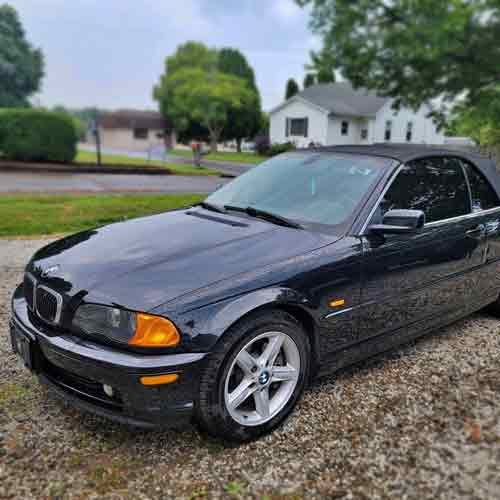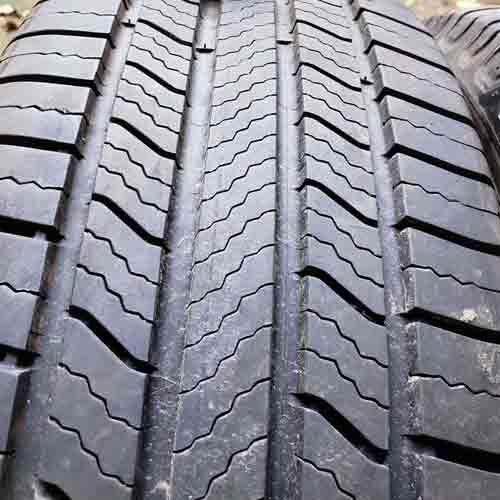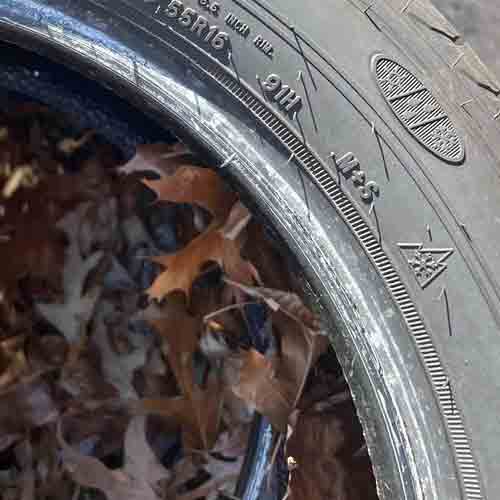The Assurance WeatherReady is Goodyear’s Grand Touring All-Season tire, while the Michelin Defender 2 comes in standard touring category. Both tires are great options, with some distinct personalities. Let’s find them out.

So, overall, the Defender 2 shows advanced dry performance, quieter ride, increased tread life, and better fuel efficiency. In contrast, the Assurance WeatherReady excels in wet and winter conditions due to (especially with it’s rubber composition), and also delivers superior ride comfort.
Table of Contents
Tire Structure
The Michelin Defender 2 showcases a streamlined symmetric pattern.

First off, the tire comes with a rounded contact patch, which allows it to distribute its weight more evenly.
Though the tire is very light to begin with, especially compared to Goodyear here.
It’s 5 rib design, has its outer 2 shoulder ribs with simplistic designs, where they only carry lateral voids, and mere interlocking siping.
Similar siping is seen on the internal 3 ribs, though on each, with varying angles.
The middle most rib is continuous running and has more of these sipes, while the adjacent ones also have wave-like grooves as well.
Inside, the Defender 2 is fortified with a single-layer polyester casing, paired with two steel belts and a nylon cap ply.
Switching focus to the Goodyear Assurance WeatherReady, this tire exhibits a distinctively asymmetric design, with all of its five ribs displaying varied characteristics.

Notably, its needle-like lugs provide exceptional ice traction.
While the central three ribs form longitudinal channels, but they stand out mostly due to their interconnected, more voided up structures.
The central-most rib is notably narrower and is characterized by wave-like siping, in-groove notches, and offset edges.
Moreover, it also carries thick interlocking lateral grooves.
And speaking of adjacent ribs, they equally intriguing, where one offers jagged lugs with chamfered edges, while the other has zigzag edges (facing the shoulders) and chamfered sides.
Though the shoulder lugs maintain consistency on either side though, “almost”.
Internally, the tire is built with a two-ply polyester casing, strengthened by wider dual steel belts and a polyamide-reinforced cap ply.
Info on Available Sizes
Let’s take a quick look at their sizes and specs.
| Features | Michelin Defender 2 | Goodyear WeatherReady |
|---|---|---|
| Rim Size (inches) | 16 to 20 | 15 to 20 |
| Speed Ratings | H (all sizes) | T, H, V |
| Load Ratings | SL, XL | SL, XL |
| Tread Depth (32″) | 10.5 (all sizes) | 10 or 11 |
| Weight Range (lbs) | 25 to 32 | 19 to 37 |
| Winter Ratings | M+S (no 3PMSFR) | M+S/3PMSF |
| Mileage Warranty | 85k miles | 60k miles |
| UTQG Rating | 800 A A | 700 A A |
| Detailed Review Link | Defender 2 Review | Goodyear Assurance Review |
Dry Performance
Dry tire performance is primarily segmented into three crucial categories: dry grip, handling, and steering responsiveness.
Let me discuss each of these aspects one by one.
Dry Grip
Directional grip is the tire’s straight line grip and is measured by it’s braking capability. Now this grip highly depends on the central tread area, as that’s where the majority of the rubber interacts with the road, (during straight-line motion).
So it’s not a surprise that the Assurance WeatherReady is lacking here, in comparison.
This tire features both lateral and longitudinal voids throughout the tread, which reduces the rubber volume available for direct road engagement, inevitably impacting grip.
Furthermore, its somewhat denser, yet softer compound increases momentum, making it slightly more challenging to stop (as seen on braking tests).
In contrast, the Michelin Defender 2 stands out, achieving a harmonious balance between braking and acceleration.
Now sure, it’s three continuous central ribs are instrumental to this exemplary performance, (as they form consistent contact with the road’s surface).
But most of it’s grip is coming from it’s light weight design with ribs having robust reinforced foundations underneath. So its simple math, being lighter, it brakes 8 feet shorter on average (as seen on tests).
Dry Handling
Handling encompasses both the lateral grip and the steering response of a tire.
And here once again the Michelin Defender 2 takes lead, demonstrating remarkable performance, primarily due to its expertly crafted shoulders.
These shoulders, being the main contact points with the road, ensure superior rubber-to-road interaction, where their minimalist and more streamlined tread design ensures enhanced lateral traction.
In contrast, the Goodyear Assurance WeatherReady falls really short. I mean, although its lateral grip is also pretty decent, relatively, it still trails the Michelin by over 2 seconds, as seen in average lap handling times (tests).
But why?
Well, this is because the Goodyear’s tire comes with a heavier build, combined with a softer rubber composition. While these attributes enhance its performance on snowy terrains, they also predispose the tire’s lugs to flex.
And this lug flexion is detrimental to overall handling, as they ask for time to regain the tread’s original form, and this delay is (literally) added in the overall lap times.
Fuel Consumption
When it comes to fuel efficiency, rolling resistance is a pivotal factor. And this resistance is intrinsically linked to the tire’s weight/composition and grip.
Now out of both tires, the Michelin Defender 2 emerges as the front-runner in this regard:
- Its design incorporates closely packed and more streamlined ribs/lugs, optimizing energy use.
- With stiffer rubber, it doesn’t waste energy on heat generation or tread deformation, and keep things “economical”.
In contrast, the Assurance WeatherReady presents challenges, and the tire lacks with:
- Its heavier construction, pushes down its tread more, causing lugs to bend (which asks for extra energy to reshape them back).
- It’s presence of more biters, which combined with the tire’s softer rubber, generate greater rolling friction.
Side Note: As the Goodyear’s tire produces more rolling resistance, it makes sense that its speed ratings go up to V, whereas in case of Michelin, all sizes are rated with only “H”.
Also: Speed rating is directly proportional to rolling resistance/fuel consumption. I explained it more here.
Ride Comfort
Touring tires are primarily crafted to deliver a serene and effortless journey, excelling in absorbing bumps and reducing noise.
Let’s discuss both these factors one by one.
On Road Vibrations
There are two key factors to contemplate when evaluating road vibration dampening:
- The tire’s function as an auxiliary suspension system.
- The overall consistency and poise of the ride.
And in both of them, the overall construction of the tire is one of the most crucial aspects.
Meaning, it makes sense why the Michelin Defender 2 is lacking here, with its stiffer nylon cap ply (internal construction), and a more rigid rubber on top, where it’s tread is further reinforced with yet another “harder” rubber layer, (lugs/ribs are actually sitting on a secondary layer).
On the other hand, the Goodyear Assurance WeatherReady excels as it’s furnished with “relatively softer” (thermally adaptive and 3PMSF certified) rubber.
Noise Dampening Ability
The primary source of tire noise is the interaction of air particles with the tread surfaces.
And with a more open structure, the Goodyear Assurance WeatherReady doesn’t perform as well in this respect. Meanwhile, the Defender 2 stands out as a quieter choice, producing only a subtle hum that melds seamlessly into the background ambience.
Moreover, Michelin’s quieter ride is also attributed to the tire’s more sophisticated variable pitch pattern.
This design introduces multiple interaction points on the lugs. As air particles strike these points, they generate a range of sound frequencies that counteract one another, effectively diminishing overall noise.
Tread Longevity
Tread life hinges on numerous factors, and to accurately determine a tire’s lifespan, one must consider elements such as tread compound, design, depth, and the tire’s (construction) weight.
And considering these once can easily tell, the Michelin Defender 2 stands out distinctly. (It’s, in-fact, one of the most lasting tire, in its standard all-season category)
So what makes this tire so great? Well, there are 3 key reasons here:
- The tire comes with a lighter design, enhanced with MaxTouch technology. This means its tread endures less weight pressure, minimizing rolling friction.
- It features EverTread compound, which put simply is, rich in heat-resistant polymers, directly extending the tire’s tread life.
- And it’s symmetric tread design facilitates, smoother tire rolling (keeping rolling resistance low).
On the other hand, the Assurance WeatherReady has a greater weight focusing on a smaller lug area, (due to its more open tread pattern).
So each lug burns down with greater force, leading to wear. And yes, here it’s softer compound acts a catalyst to this overall process.
Overall Wet Performance
A tire’s wet performance is primarily determined by its capability to swiftly disperse water from its tread, ensuring continuous rubber-to-road contact, and this is accomplished through the synergy of grooves and sipes.
Grooves play a vital role in combating hydroplaning, where they provide clear pathways for water to leave out. While sipes complement this, by effectively removing residual water.
These sipes basically suck up water particles in their slits, (and they have to be flexible enough to do that).
Having said that, now I can explain why here, the Goodyear Assurance WeatherReady emerges superior. The tire offers better overall wet braking, handling and acceleration, along with a more responsive steering.
As it’s design incorporates a more voided up structure, its able to throw out more water, right from the start.
Moreover, with numerous and milt-directional biters, combined with both linear and wave-like (interlocking) siping patterns, the tire ensures efficient removal of any remaining water particles, in a much better way as well.
On the flip side, the Michelin’s tire falls behind, with it’s more rigid rubber composition. So despite having a lot of interlocking sipes, you still see a lacking overall wet performance on this tire, where sipes aren’t able to breath water particles easily.
So, comparatively, Defender 2 lacks in both hydroplaning resistance and overall wet traction.
Winter Performance
When it comes to winter traction, there are 3 main performance metrics, and 2 different types of terrains involved. I mean there’s handling, directional grip and acceleration, on both ice and snow.
Now here, the Defender 2 with it’s populated interlocking siping, may seem to provide decent overall performance values, it’s actually quite the opposite, where it’s stiffer rubber is the main culprit.
You see, biters tend to lose their flexibility with harsh freezing conditions, and that leads to significant slippage. So you need a tire with a thermally adaptive rubber, with a 3-peak mountain snowflake (3PMSF) rating.
And that’s where the Goodyear WeatherReady comes in.
The tire with 3MPSF certification offers better performance especially when the temperature goes below below 7°C (or 44.6°F).
Moreover, it’s greater weight and more voided up structure provides superior snow scooping, throwing snow backwards and generating better acceleration against it. And yes, it’s biters also provide you with a more effective snow to snow contact (as they trap in the snow particles in their voids).
(This is crucial as snow tends to bind better to itself than to rubber).
Furthermore the Goodyear Assurance also performs remarkably on icy terrains (where Defender lacks severely).
And this superior performance is attributed to the tire’s asymmetric tread design, which is engineered with several traction-enhancing features such as zig-zag/chamfered edges, needle-like grooves, and in-groove notches oriented at various angles (delivering grip in all directions).
Concluding Remarks
To sum it up, both tires have distinct positives and room for growth, depending on the driving context.
The Michelin Defender 2 excels in the following:
- Enhanced dry performance, due to its lightweight design and robust rib foundations.
- Superior dry handling, and steering responsiveness.
- Quieter ride, with advanced noise dampening features.
- Greater tread longevity, with its heat-resistant polymers and MaxTouch construction.
- Better fuel efficiency, owing to lower rolling resistance.
While the Goodyear Assurance WeatherReady takes the lead in:
- Overall wet performance, with its efficient water dispersion and multi-directional sipes.
- Winter performance, especially on snow and ice, due to its 3PMSF rating and thermally adaptive rubber.
- Ride comfort, with softer rubber that better absorbs road vibrations.